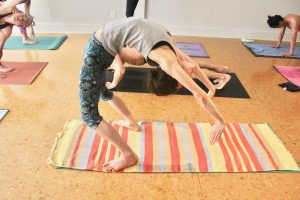Maybe it’s not that it should always be hard. Maybe it’s that it should always be interesting. – Sarah Teitel
About three years ago, I stood up from urdhva dhanurasana for the first time. It took five years of trying. I didn’t get the dynamics, I didn’t get the orientation, I didn’t get the motion. I got frustrated, which didn’t help. Then I got mad. Mad at my stuckness, mad at the room, mad at the person in front of me who launched back from bakasana and knocked my hand with her foot. The madness overrode the fear. I stood up. “It’s so easy!” I said.
Or not.
In the three years since, I’ve gone through phases. Phases where I flume down, touch a beat, and reverse-cascade right back up. Phases where I have to chug – catch air several times with nominal (at best) propulsion – before I manage a legitimate push. Phases where I freeze. Where my hands won’t peel themselves from the floor.
Lately, I’ve been chugging. It’s better than freezing, but it’s no cascade.

I think – I believe – that I’m learning. That connections are being made. That the struggle is strengthening. I find it’s easier to rise if I remind myself to smile; to laugh. Not at the challenge, but with it. Laughing is nicer when there’s company.
Last Sunday, I laughed with Nathan Wilton, who was heading the mysore room. “Come stand by me,” I said. “I’m doing more than I need to. Tell me to just come up.”This approach – the buddy system – had worked once. Except a token aspect of my urdvha danurasana
“It’s in your head,” Nate said.
“Isn’t it always.” I replied.
“No such thing as tight body,” Nate said, “only tight mind.”
I bristled. I didn’t like the implication that I was tight-minded.
“We all have tight minds about something,” I said, not wanting to be tight about the prospect of my own inflexibility.
I like to imagine myself as loose, spontaneous, allowing. I think I am all those things. On the other hand – and I noticeI’m less eager to announce this – I’m tight: precise, critical, disciplined. I don’t
So why am I reluctant to admit to being tight when I’m so ready to accept that I’m loose?

Is it that I think looser people are better liked? Is it that I need to be tight for reasons I don’t fully understand – reasons I’m confused by or ashamed of? Is it that there’s some elusive, beautiful looseness I perceive in the universe or at least can imagine existing that I desperately want and haven’t yet managed to achieve? Is it all those things?
A few days after the back-and-forth with Nathan, I was still chugging to rise from urdhva dhanurasana. It was a weekday, and David Robson was teaching. After I’dmanaged to stand on my own the requisite number of times, David approached to assist me. “It got hard again,” I told him, in case he hadn’t noticed. David nodded and guided me through the last bit of the sequence.
“Your alignment’s not bad,” he said.
“It’s changing,” I said, “I think that’s why it’s hard again.”
David moved off, then looked back.
“Maybe that’s your metric,” he said.
I can’t remember if David actually voiced what I felt he was implying – that it should be hard.
Whether tacit or spoken, the idea was a salve. It made my chugging seem more graceful. And then, wouldn’t you know, just as I’d made a sort of peace with chugging – had even begun to look forward to it a little – things shifted. Today
And so I’m left to reconsider my take on the metric. This morning, I wasn’t able to measure by difficulty. Yesterday’s reference point no longer applied. I didn’t predict the change, but I
Maybe that’s my metric. Maybe it’s not that it should always be hard. Maybe it’s that it should always be interesting.

Things that have (all) helped and (all) not helped me to stand from urdhva dhanurasana:
-thinking of rootedness
-thinking of motion
-thinking of people I love
-thinking of the man in me
-thinking of the woman in me
-thinking of the non-binary fortitude in all of us
-wearing one bracelet on my left wrist
-wearing two bracelets on my left wrist
-using the words “Leonard Cohen” as a sort of abracadabra
-trying to push myself through the window (if practicing in the front row)
-trying to push myself through to a glass of wine (if practicing in the evening)
-trying
Sarah is a daily practitioner at AYCT as well as an artist and singer/songwriter. You can catch her over on instagram or on her website to say hello!
If back-bending is something you struggle with, our very own David Robson has a great video available on his website: Principles of Pain Free Back-bending.
How do you feel about coming up to standing? Does it come easily to you, or is it a struggle? Let us know in the comments below!

Lovely article! I love the lightness this brings into such a challenging part of the practice.
I struggle (hard) with back bending, always have. Nowadays, I struggle more. I injured my back last year during a practice and have had pain in the lumbar ever since. My back bending practice is very hit or miss right now. I feel like I’m always searching for an answer, like something is going to be like “hey, this is what you should be doing”. I guess that’s part of the journey, is knowing this answer is within the whole time.